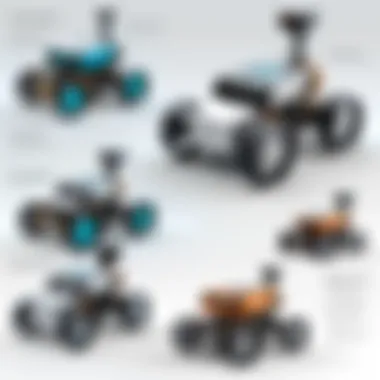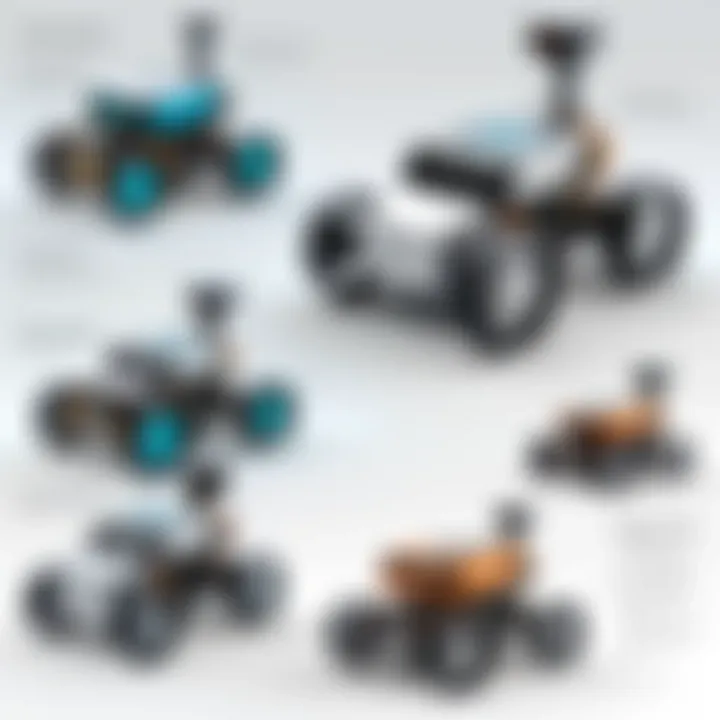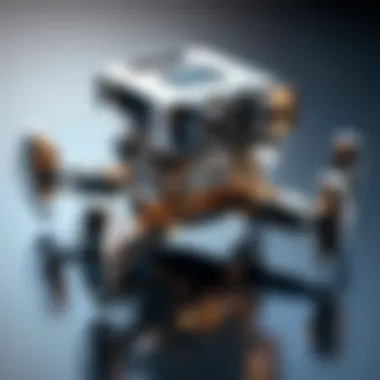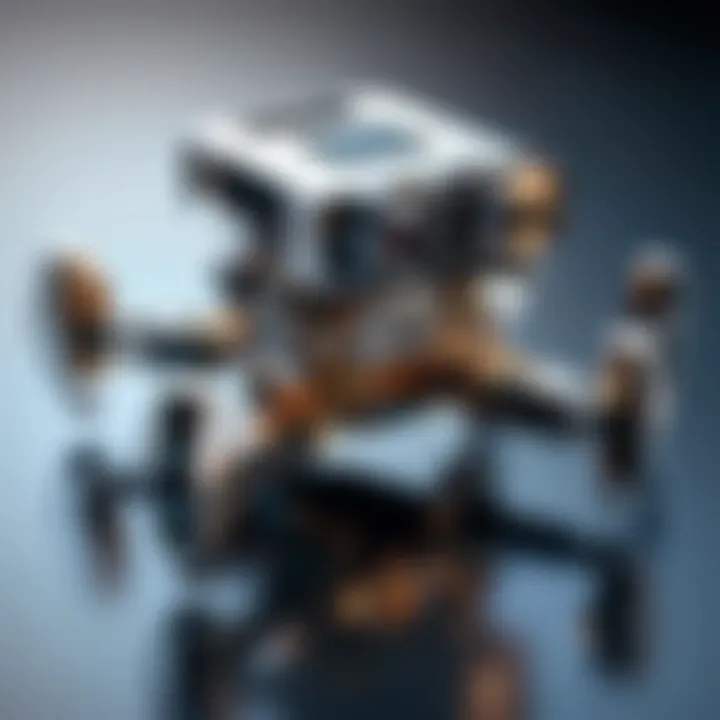Innovations in Cell-Sized Robots and Their Applications


Intro
The concept of cell-sized robots captures inquisitive minds, presenting a fusion of biology and technology. As tools advance, miniaturization has emerged as a significant trend. Cell-sized robots stand at the forefront, providing new avenues for research and application across various industries. Understanding their development, function, and potential impacts reveals much about the future of robotics and biotechnology.
It is essential to assess the design intricacies of these robots. Their small scale enables novel methods for delivering drugs, conducting research at the cellular level, and even performing repairs within biological systems. However, their implementation is not without ethical considerations, making this a multifaceted topic worthy of exploration.
Technology Insights
Latest Tech Trends
Recent advancements in nanotechnology have enabled the production of cell-sized robots. These robots may vary in design based on their intended function. For instance, some are equipped with sensors that allow them to gather data from their environment, while others can interact with cellular structures. The integration of artificial intelligence further enhances their capabilities. The innovation in robotics primarily emphasizes precision and control, critical for applications in sensitive biological systems.
Innovation in Tech
The innovative edge of cell-sized robots encompasses various forms, materials, and mechanisms. Researchers are experimenting with biocompatible materials, ensuring these robots can safely operate within biological environments. This innovation is not limited to the design but also extends to the software side. Advanced algorithms enable these robots to learn from their surroundings, adapt their functions, and perform complex tasks autonomously. The implications of these technologies stretch from medical uses to environmental monitoring.
"Cell-sized robots represent a leap in how we will interact with biological systems, offering solutions that were previously unimaginable."
Product Reviews
While specific commercial products may not yet widely exist, various prototypes are in development. These include drug delivery systems designed to target specific cells and diagnostic tools that can assess health conditions at the cellular level. The reviews of these technologies often highlight their potential but also emphasize the necessity for further testing to ensure safety and effectiveness in real-world applications.
Ethical Considerations
With technology advancing rapidly, ethical discussions surrounding cell-sized robots are increasingly relevant. The potential for micro-robots to alter biological systems raises concerns about unintended consequences. How do we regulate their use? Furthermore, issues such as privacy, consent, and the potential for misuse must be addressed as research progresses.
In summary, the study of cell-sized robots involves understanding their technological innovations, applications across different sectors, and the ethical landscape that accompanies their development. As this field evolves, it will challenge traditional boundaries and drive new conversations about the intersection of technology and biology.
Prelude to Cell-Sized Robots
Cell-sized robots represent a cutting-edge intersection of technology and biology. Their ability to mimic natural cellular functions provides significant potential in various fields, particularly in medicine and environmental monitoring. Understanding the underlying principles of these robots is crucial for appreciating their transformative capabilities.
Definition and Overview
Cell-sized robots are miniature machines designed to operate at the cellular level. These tiny entities can perform specific tasks such as drug delivery, cellular repair, and diagnostics. Their small size allows them to navigate complex biological systems and interact with cells in a targeted manner. The integration of advanced materials and engineering techniques enables these robots to perform functions once unimaginable. Biocompatibility is essential, ensuring they do not provoke immune responses in biological environments. This aspect is vital for their success in medical applications.
Historical Context
The concept of utilizing tiny machines can be traced back to the 1950s. Early theoretical explorations laid the groundwork for what would eventually evolve into practical applications. The term "nano-robotics" gained traction in the late 20th century, with advancements in materials science and microengineering techniques facilitating the development of true cell-sized robots. Early prototypes focused primarily on drug delivery. Over the past decade, significant advancements have allowed for more sophisticated designs capable of performing complex tasks, such as self-replication and real-time environmental monitoring. The journey from concept to functional devices reflects the rapid technological progress within this emerging field.
Technological Foundations
The section on Technological Foundations serves as a cornerstone in the understanding of cell-sized robots. This area encompasses several vital components that facilitate the design, functionality, and application of these micro-robots. The advancements in materials, engineering techniques, and energy supply configurations lay the groundwork for innovations that can significantly impact various fields. A thorough comprehension of these technological foundations enables researchers to push the boundaries of what is achievable in robotics and biotechnology.
Materials Used in Construction
Biocompatible Materials
Biocompatible materials are paramount in the development of cell-sized robots intended for medical applications. These materials are designed to interact safely with biological systems. Their key characteristic lies in their ability to coexist with cells without eliciting an adverse reaction. This is crucial for ensuring that the robots do not trigger inflammation or other negative responses from the body.
Biocompatible materials, like hydrogel and polyethylene glycol, are popular choices because they are adaptable and can be engineered to meet various needs. A significant advantage of using these materials is their compatibility with human tissues, allowing for seamless integration. However, one drawback is the potential for degradation over time, which can limit the robot's operational lifespan.
Nano Materials
Nano materials bring a unique dimension to the construction of cell-sized robots. Their specific aspect is their scale; they are engineered at the atomic level, providing unprecedented precision in design. The key characteristic of nano materials is their enhanced properties, such as increased strength and conductivity, compared to their larger counterparts. This makes them highly beneficial for use in technologies requiring miniaturization.
Moreover, nano materials possess remarkable flexibility in function. For instance, carbon nanotubes can be used for efficient drug delivery by creating pathways within biological systems. Yet, the potential toxicity of some nano materials cannot be overlooked, posing a risk to health and the environment. Thus, while they present exciting opportunities, careful evaluation is essential.
Microengineering Techniques
3D Printing at Micro Scale


3D printing at micro scale is a revolutionary technique that has transformed how cell-sized robots are fabricated. This method allows for precise layering of materials, enabling the creation of intricate designs that are impossible to achieve through traditional manufacturing processes. A key characteristic is its adaptability; it can quickly produce different prototypes, fostering innovation.
This technique is particularly beneficial because it reduces waste by using only the necessary amount of material during the printing process. Additionally, it facilitates rapid prototyping, allowing for quicker iterations of robot designs. However, challenges remain in achieving consistent precision at this scale, which can error introduce into the final product.
Lithography Methods
Lithography methods play a crucial role in the microfabrication of cell-sized robots. This process involves using light and other forms of radiation to create patterns on a substrate. The key characteristic of lithography is its high-resolution capability, enabling the production of complex features that are well-suited for micro-sized applications. This makes it a staple in the semiconductor industry, expanding its relevance in robotics.
One unique feature of lithography is the ability to incorporate multiple materials within a single process, leading to multifunctional robots. Nevertheless, the complexity and cost of lithography equipment can present barriers to entry for smaller research teams.
Power Supply and Energy Harvesting
Microbatteries
Microbatteries are essential for powering cell-sized robots, especially in applications where compactness is crucial. They are designed to fit within the small confines of these robots while providing adequate energy output. A key characteristic is their miniaturized design, which allows for integration without significant weight or space penalties.
Their primary advantage lies in their ability to supply consistent power for extended periods, which is vital for operational efficiency. However, their capacity remains a limitation, as microbatteries might not sustain long-lasting operations without recharging.
Energy Harvesting Techniques
Energy harvesting techniques provide an innovative solution to power supply issues. These methods capture energy from the environment, such as heat or motion, converting it into usable electrical energy. The key characteristic of energy harvesting is its ability to prolong the operational life of cell-sized robots without the need for frequent battery replacements.
These techniques can enable continuous operation, a significant advantage in medical applications where robots may need to function inside the human body for extended periods. However, the efficiency and scale of energy harvesting are still ongoing challenges, necessitating further optimization to maximize energy capture in real-world applications.
Types of Cell-Sized Robots
Understanding the different types of cell-sized robots is crucial for comprehending their applications and capabilities. Each category represents unique innovations addressing specific needs in technology and biology. Their design and operational functionalities can significantly impact fields like medicine, environmental science, and manufacturing.
Swarm Robotics
Swarm robotics refers to the design and operation of multiple small robots working collaboratively, resembling swarming behavior seen in nature, like ants or bees. This technology allows for parallel task execution, enhancing efficiency in various applications, from environmental monitoring to healthcare solutions. Swarm robots can also adapt to new situations and redistribute tasks among themselves, improving resilience.
A significant advantage of swarm robotics is their scalability. As the size and number of robots increase, the system's capabilities broaden, allowing more complex tasks to be undertaken. However, managing communication and coordination between numerous agents remains a challenge. Without effective communication, the swarm could face confusion or redundancy in task execution.
Self-Replicating Robots
Self-replicating robots present a fascinating innovation. They possess the ability to create copies of themselves using available materials in their environment. Such a characteristic allows for the expansion of robot populations without the need for external resources, which could revolutionize fields like space exploration. Imagine a future where robots could be sent to distant planets to build colonies using local materials.
The implications of self-replication extend beyond space. In medicine, these robots could facilitate tissue regeneration by replicating themselves using cells from the patient’s body. However, ethical concerns arise with this technology, especially regarding control and the potential for unintended consequences in their operation.
Targeted Delivery Systems
Targeted delivery systems are designed for precise transportation of drugs or biological agents to specific cells or tissues within a body. This technology leverages the advantages of cell-sized robots, minimizing side effects and improving treatment effectiveness. Targeted delivery can significantly enhance the efficiency of pharmaceuticals, particularly in cancer therapy, where it enables direct treatment of tumor cells while sparing healthy tissues.
Moreover, these systems can adapt to detect specific biological markers found on targeted cells, enhancing their accuracy. The potential for targeted delivery systems to improve patient outcomes is immense, as it transforms conventional treatment methodologies into more sophisticated and effective practices.
"The precision of targeted delivery systems could change how we approach treatment in medicine, moving us toward personalized healthcare solutions."
In summary, exploring the types of cell-sized robots reveals pivotal advancements in technology. Swarm robotics, self-replicating robots, and targeted delivery systems are leading examples that showcase their potential to solve complex challenges across various domains.
Applications in Medicine
The realm of medicine stands to benefit greatly from the advancements in cell-sized robotic technologies. These miniature robots can revolutionize various aspects of healthcare, including treatment delivery, patient monitoring, and overall diagnostic procedures. Their importance lies in their ability to enhance precision in medical practices, improve patient outcomes, and minimize the risks associated with traditional treatments.
Drug Delivery Mechanisms
Cell-sized robots are designed to deliver drugs accurately to specific sites within the human body. Traditional methods of drug administration often result in systemic distribution, which can lead to side effects or inefficacious treatment. In contrast, these micro-robots can navigate through bodily fluids and target specific cells or tissues. This system minimizes the dosage needed and reduces the potential for adverse reactions.
Research indicates that these robots can be engineered to respond to environmental cues or external stimuli, allowing for controlled release of therapeutic agents. For instance, if a robot detects an area of inflammation, it could release anti-inflammatory drugs directly at the site, optimizing treatment effectiveness.
Diagnosis and Monitoring
In addition to drug delivery, cell-sized robots also hold promise in diagnostics. They can be deployed to gather real-time data about a patient’s internal condition. Equipped with sensors, these robots can measure various biomarkers indicative of diseases. This can significantly speed up the diagnosis process. For example, in conditions where rapid intervention is critical, such as sepsis, timely data can be life-saving.


Moreover, continuous monitoring is possible with these devices. They can operate within the body for extended periods, gathering essential information without the need for invasive procedures. This capability may change the way chronic diseases are managed, making it easier to adjust treatments based on patient feedback.
Targeted Cancer Treatments
Cancer treatment is another area where cell-sized robots are making strides. Targeted therapies are essential in cancer treatment as they attack cancer cells while sparing healthy ones. Micro-robots can be programmed to identify cancer cells using specific markers on their surface. Once the robots detect these markers, they can deliver chemotherapeutic agents directly to the tumor.
Such precision in treatment reduces the collateral damage typically associated with drastic chemotherapy methods. It also optimizes the effectiveness of drugs, potentially leading to better prognosis and quality of life for patients. As this technology evolves, it could pave the way for more personalized cancer treatment plans tailored to individual patients' tumor characteristics.
"The intersection of robotics and medicine could lead to unprecedented innovations in patient care and treatment methodologies."
The integration of cell-sized robots in medicine depicts a transformative approach to tackling some of the most pressing health issues today. The ongoing research in this area promises to expand these applications further, showcasing the potential to change how diseases are diagnosed and treated.
Impact on Industry and Research
The advent of cell-sized robots marks a pivotal shift in various sectors, underscoring their potential transformative impact on industry and research. This section explores the multifaceted roles these micro-robots may play, addressing specific applications, advantages, and the unique considerations associated with them.
Manufacturing Applications
Cell-sized robots have significant implications for manufacturing processes. Their small size enables them to manipulate materials at micro and nanoscale levels, which is crucial in industries like electronics and pharmaceuticals. For instance, these robots can perform precise assembly tasks, ensuring increased accuracy while reducing waste.
- Enhanced Precision: By utilizing cell-sized robots, manufacturers can achieve unparalleled precision in tasks such as circuit assembly. This increases product quality and reduces the chances of defects.
- Cost Efficiency: Automating certain processes with these robots can lead to significant cost savings in labor and materials.
- Customization: Industries can respond faster to market demands by implementing robots capable of rapid reconfiguration to produce different products without extensive downtime.
In summary, the integration of cell-sized robots into manufacturing not only streamlines operations but also opens new pathways for innovation.
Environmental Monitoring
The potential for cell-sized robots in environmental monitoring is substantial. These robots can be deployed in delicate ecosystems to gather data on pollution levels, biodiversity, and climate indicators. They can access areas that are challenging or unsafe for humans to reach, providing invaluable insights.
- Remote Sensing: The ability of these robots to operate in diverse environments allows for accurate data collection across varied landscapes. This is particularly beneficial for studies related to climate change.
- Real-Time Monitoring: Continuous monitoring becomes feasible, allowing for swift responses to environmental changes or threats.
- Cost-Effective Solutions: Using micro-robots for monitoring can reduce the costs associated with traditional methods, such as manned research stations or satellite surveillance.
Their deployment contributes positively to sustainable practices by enhancing the precision of data collection and promoting environmentally responsible monitoring activities.
Exploration and Data Collection
Cell-sized robots hold impressive promise in fields requiring data collection and exploration, such as geology, oceanography, and space research. Their compact design allows them to navigate challenging terrains and collect data without disturbing the surrounding environment.
- Versatile Deployment: These robots can be employed in diverse settings, from deep-sea exploration to remote planetary surfaces. Their adaptability is vital for accumulating data in places previously considered unreachable.
- Data Precision: The capacity to gather detailed information, such as chemical compositions of soil or water samples, vastly improves research quality.
- Collaborative Exploration: Swarm robotics can be utilized, where multiple robots work together, gathering vast amounts of data in a coordinated manner.
The rise of cell-sized robots could redefine scientific research by making data collection more accessible and efficient.
Design Challenges and Considerations
The design of cell-sized robots involves several significant challenges that influence their efficiency and functionality. Addressing these challenges is crucial for maximizing their potential in various applications. This section emphasizes the importance of understanding design challenges and considerations associated with these micro-robots. Only by tackling these obstacles can the next stage of innovation in this field be achieved.
Scaling Issues
One of the primary challenges in designing cell-sized robots is scaling. The laws of physics change at microscopic levels, particularly regarding fluid dynamics and material properties. For instance, when robots are miniaturized to the scale of cells, surface tension becomes a dominant force. This can impact their movement and interaction with the environment. Engineers must develop designs that account for these phenomena to ensure reliable operation in biological contexts.
Moreover, the materials used in manufacturing these robots must be lightweight yet sturdy enough to withstand the various environmental conditions they may encounter. The selection of suitable materials, such as biocompatible polymers or metals, plays a crucial role in the scaling process. Innovative approaches, like using nanoscale materials that maintain strength while minimizing weight, are essential in addressing this challenge.
Navigational Challenges
Effective navigation is another significant consideration when designing cell-sized robots. In biological systems, they often need to traverse complex microenvironments, which can include tightly packed cells or viscous fluids. Unlike traditional robots that may rely on GPS or visual sensors for navigation, cell-size robots must utilize different methods, such as chemical sensing or motorized cilia, to navigate effectively.
For instance, using chemotaxis, these robots can detect and follow chemical gradients, allowing them to target specific areas within a biological system. This requires advanced programming and adaptability to respond to changing conditions in real-time. Additionally, the need for obstacle detection and avoidance mechanisms becomes vital to prevent undesired interactions with surrounding cells or tissues.
Control and Communication
Control and communication systems are pivotal in the functioning of cell-sized robots. With their small size and often limited power supply, developing effective methods for communication poses challenges. Traditional communication methods may be too cumbersome or inefficient at such a small scale.
New approaches must focus on simplicity and efficiency. For example, utilizing molecular signaling systems or simple wireless communication techniques can enable coordination among multiple robots. This is crucial for swarm robotics, where numerous robots work together to carry out complex tasks.
"The ability to control multiple cell-sized robots efficiently can redefine their capabilities in diverse fields, such as medicine and environmental monitoring."


In summary, the design considerations for cell-sized robots encompass a wide range of factors. From scaling issues to navigation and communication, these elements are essential in creating functional, effective micro-robots. Addressing these challenges holistically will pave the way for their successful integration into various applications, ensuring that they can operate efficiently and reliably in environments that differ significantly from traditional robotics.
Ethical Implications
The emergence of cell-sized robots presents significant ethical considerations that demand a careful exploration. As innovations in technology progress rapidly, the implications of their application in real-world scenarios become increasingly important. The ethical discourse around these robots is multifaceted, encompassing privacy, potential misuse, and regulatory frameworks. Addressing these issues is crucial for building public trust and ensuring responsible use of technology.
Privacy Concerns
Cell-sized robots, by nature, operate at a microscopic level. Their potential applications can include monitoring biological systems or gathering data from environments. Such tasks raise significant privacy concerns. The ability to gather sensitive information from human subjects or personal spaces without consent can lead to serious ethical dilemmas. The medical field notably stands under scrutiny in this domain. Patients could unknowingly become subjects of surveillance by such devices, leading to breaches of personal health information or sensitive data.
In light of these concerns, it is essential to establish strict guidelines. Transparency about data collection practices should be a priority.
Potential for Misuse
With the capabilities of cell-sized robots comes the risk of potential misuse. These technologies can be weaponized or exploited for malicious purposes. For instance, self-replicating robots could unintentionally cause environmental disruptions or, in worst-case scenarios, be directed towards harmful objectives.
The capacity for misuse underscores why robust safeguards must be in place. Developers and researchers need to ensure that ethical considerations are part of the design process. Awareness and educational initiatives can help mitigate risks associated with misuse.
Regulatory Frameworks
A pressing need arises for comprehensive regulatory frameworks that govern the use of cell-sized robots. Current regulations often lag behind technological advancements, creating a gap in oversight. Effective frameworks should cover several areas,
- Data Protection: Upholding user privacy and data security.
- Approval Processes: Ensuring thorough examination before deployments.
- Ethical Standards: Setting clear moral guidelines for design and usage.
Collaboration among technologists, ethicists, and policymakers is critical. Constructing these frameworks can lead to a balanced approach that fosters innovation while still protecting societal interests.
"Navigating the ethical landscape of cell-sized robots is not just about addressing concerns but also about promoting responsible innovation."
These ethical implications are crucial to consider as society progresses into a new era defined by microscopic machinery. Understanding and addressing these facets will pave the way for responsible adoption and integration of cell-sized robots into various applications.
Future Prospects
Future prospects for cell-sized robots represent a critical avenue for discussions surrounding innovation and technology. As advancements in microengineering and robotics continue to evolve, these tiny machines hold potential that may revolutionize various fields from medicine to environmental science. The pursuit of enhanced functionality and new applications drives researchers and technology enthusiasts alike to explore what is within reach.
Technological Advancements on the Horizon
The area of technological advancements is a dynamic aspect of cell-sized robots. Innovations in materials science, particularly the development of biocompatible materials, pave the way for more sophisticated designs that can interact with biological systems without causing adverse reactions. In addition, improvements in microfabrication techniques such as two-photon lithography are enabling the creation of more complex structures at the microscale.
As battery technology progresses, microbatteries are becoming more efficient and sustainable. Energy harvesting techniques that allow these robots to capture energy from their surroundings would further enhance their capability. This means future iterations of cell-sized robots could operate autonomously in real-world applications, powered solely by ambient energy sources.
Potential New Applications
With continuous advancements, the potential for new applications remains a topic of great interest. In the medical field, targeted drug delivery is one of the key areas where cell-sized robots may take center stage. These robots could deliver medications to specific affected areas, reducing side effects and improving patient outcomes.
Environmental applications also show promise. Cell-sized robots may be utilized for monitoring environmental changes, sampling pollutants, or even assisting in clean-up efforts. As cities evolve, smart technologies embedded in these robots can contribute significantly to urban sustainability efforts.
"Cell-sized robots have the potential to redefine boundaries of technology and intervention in healthcare and environmental management."
Interdisciplinary Research Opportunities
The future of cell-sized robots lies in interdisciplinary collaboration. Fields such as biology, engineering, and computer science must converge to push the boundaries of what is achievable. For example, integrating artificial intelligence with microfabrication techniques opens new doors for autonomy, learning, and adaptation within robotic systems.
Furthermore, partnerships between tech companies and research institutions are crucial. Joint ventures can stimulate innovation that aligns with societal needs. Collaborating on ethical frameworks also plays a significant role as these technologies advance. Addressing concerns such as privacy and misuse ensures that the evolution of cell-sized robots is responsible and beneficial for humanity.
Epilogue
The exploration of cell-sized robots is a crucial area within the intersection of technology and biology. These innovations signify not only an evolution in robotic design but also a potential revolution in practical applications across numerous fields. The various aspects discussed in this article—ranging from their technological foundations and types to the significant implications in medicine and industry—showcase how these micro-robots can impact our lives.
Summary of Key Findings
In summary, this article detailed several key insights:
- Technological advancements have led to sophisticated materials and methods enabling the creation of cell-sized robots.
- These robots are divided into specific types, such as swarm robotics and targeted delivery systems, each with unique functionalities and applications.
- The medical applications highlight significant promise in drug delivery and cancer treatment, enhancing efficacy and minimizing side effects.
- Industrial applications in manufacturing, environmental monitoring, and data collection signify a trend towards automation on a micro level.
- Design challenges, such as scaling and navigation, remain as focal points for future research.
- Ethical considerations, including privacy and regulatory frameworks, are paramount to ensure responsible usage.
Final Thoughts
The future of cell-sized robots holds expansive possibilities. As we continue to unravel their potential, ongoing interdisciplinary collaboration will be key in tackling challenges and mitigating risks. The balance of innovation with ethical considerations will shape the trajectory of this technology.
The reflections on these advancements not only offer insights for researchers but also inspire entrepreneurs and policymakers to engage with this nascent field. Continuous progress can redefine health care, enhance manufacturing processes, and address environmental challenges. Thus, as we look to the future, understanding and applying the concepts discussed will be essential.







